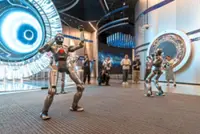Musk has a solid track record of making technology work, even though it’s usually later to market than he promises and never matches the hype that he so deftly whips up. — Reuters
Optimus, the humanoid robot that Elon Musk claims will do household chores and cure poverty, was a hit at Tesla Inc’s recent product launch. While many Musk fans came for the main event – the reveal of the company’s much-hyped robotaxi – some in the crowd appeared more impressed with the faceless, black-and-white robots that danced, served drinks and interacted with human attendees. The movements of these bipedal robots were incredibly dexterous.
It seemed almost too good to be true. And as the world later found out, it was: Tesla’s people were helping control the robot remotely behind the scenes.
Musk’s robot is likely many years away from becoming a marketable household product. But multiple companies are testing human-form robots in warehouses and on factory floors, structured settings where the technology has a much better chance of succeeding in the near term. Humanoid robots being developed by Agility Robotics, Neura Robotics, Boston Dynamics, Apptronik, Reflex Robotics and others are more capable with each new version.
Companies are interested in bipedal robots because they combine mobility with robotic arms, enabling the machine to do jobs such as packing a truck densely with different-size boxes.
But progress will be gradual. The challenge is not only for the robot to mimic human movements, but to do so safely around workers. This isn’t easy. Just ask Melonee Wise, chief product officer at Agility Robotics, whose test robot still struggles to distinguish between the plastic containers it needs to pick up and a human hand grabbing that same container. The robot isn’t viable if it mistakenly crushes a worker’s hand.
At the Oct 10 Tesla event, Musk boasted that Optimus will be able to walk the dog, put away groceries and mow the lawn. Musk has a solid track record of making technology work, even though it’s usually later to market than he promises and never matches the hype that he so deftly whips up. (He did stick the landing recently on an enormous, spent rocket booster.)
But I’m betting against his idea of a home robot having more potential than a commercial version. I’d be happy if Musk turns out right and I’m wrong, because the first thing my personal robot would learn is how to cut the grass on a 100-degree Texas summer day. Certainly, these machines shouldn’t ever be left alone to babysit kids, another task Musk claimed his robots will be able to do.
I’d expect Optimus to appear in factories long before it winds up in homes, provided the robot can meet the automation industry’s standard of a two-year return on investment. Retail settings, like fast-food restaurants, might come later. Robots might make great bartenders. But there are many reasons, including cost, maintenance and safety, that add complexity to the development of home robots. Whatever their eventual capabilities, household activities like the ones Musk touts won’t appear in anyone’s robot repertoire this decade.
Instead of household chores, Digit, the robot built by Agility Robotics, loads containers filled with Spanx shapewear products on a conveyor belt at an e-commerce warehouse in the Atlanta suburbs. The robot is quickly improving its output and is getting closer to the 20 seconds that it takes a human to do the job. Digit was last clocked at a pace of about 30 seconds, Wise said.
“We're about to go through another major optimisation, which should bring that down quite a bit,” Wise said.
Even simple tasks take a lot of programming, testing, trial and error. Wise’s team undertook a project to make Digit mimic how workers react when orders flood in and the conveyor has no open space for a container. The workers stack the boxes at the side of the conveyor belt. When the flood subsides and there is space, they place the containers on the conveyor. This is complicated stuff for a robot to tackle. But once the robot carries out a task successfully, all the robots can be programmed to copy that action.
The limitations of robots come from all the main components: the cameras, lidar and radar that create vision, the motors and actuators that enable movement, the power pack that gives it energy and the computer that acts as a brain. Digit’s battery lasts four hours – only two if it’s doing strenuous activity – and takes an hour to charge up.
Dexterity is improving rapidly. The advances that allow robots to balance on two feet have been astounding. Although our hands will likely never be matched by a machine, robots have the advantage of being able to swap out end-of-arm tools such as drills, pinchers, brushes and other so-called end-effectors that serve as robot hands.
For now, Agility’s robot is kept away from people. In a couple of years, Wise said, the company expects to have a version that will be safe to work among and interact with humans. Her company has about 15 customers that have signed or are in the process of signing contracts to use the robots.
The humanoid robots are coming, and Musk’s Optimus may be among them. Just don’t expect them to do your chores. – Bloomberg Opinion/Tribune News Service





